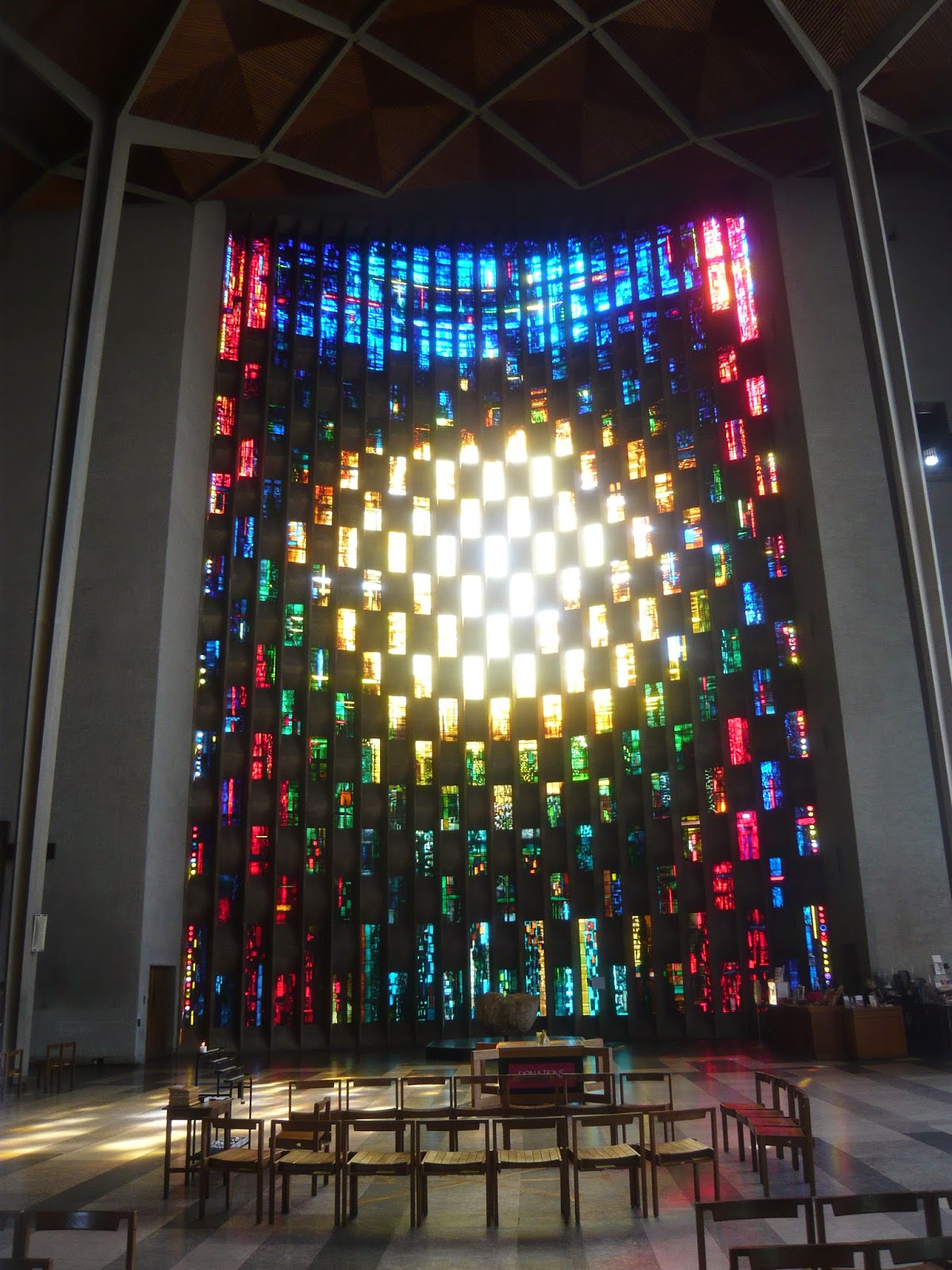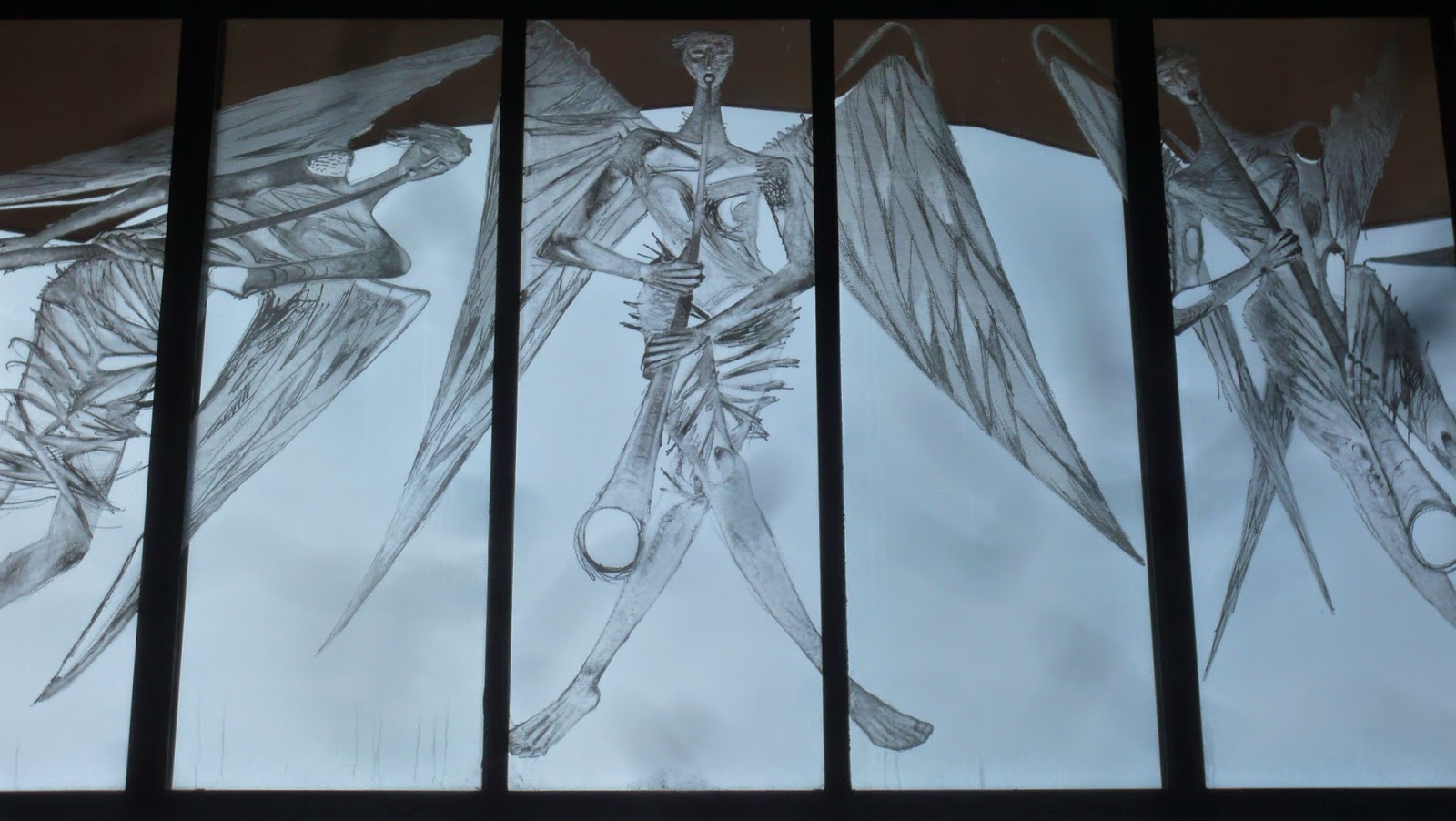Basil Spence's Coventry Cathedral, built side by side with
the ruins of the old Cathedral (bombed in 1940) and integrated with them has
become an icon of God's power at work in the world to reconcile and renew. The
current Dean, The Very Revd. John Witcombe, has written that, "The
narrative of chaos and destruction being taken and offered back to God, issuing
in resurrection and new life, is one that speaks into the reality of the lives
of many of our visitors, and many of our communities.”
Spence was the only architect in the competition to design
the new Cathedral to propose retaining the ruins of the old Cathedral and
therefore create a literal and spiritual link between old and new. This is so
right in terms of the ministry of reconciliation which Coventry
Coventry Cathedral was the first major opportunity in Britain Northampton
Hussey controversially kick-started the commissioning of
modern art by the Church in Britain Coventry
The task of reconstruction dominated the post-war years. The
Festival of Britain showcased the drive for modernity in the rebuilding of Britain Coventry
Benedict Read has written of an alternative artistic culture
provided by church commissions as a result of an almost unprecedented campaign
of church building and decoration throughout the thirty years after 1945. The commissions at Northampton and Coventry were not about engaging with an alternative
culture but the mainstream of contemporary art; Moore, Sutherland, John Piper
and Jacob Epstein were the independent masters of their time in Britain France
While the casket contains many jewels, those which shine most
brightly are Sutherland's Christ in Glory
in the Tetramorph (undoubtedly the largest tapestry in the world), the
abstract baptistry window by Piper and Patrick Reyntiens, and John Hutton's
Great West Screen. These are major statements and huge achievements both
conceptually and technically. Yet the immensity of each is also managed through
position and purpose to enable our scaled engagement. Hutton's screen can be
viewed inside and out and from the steps leading to the old Cathedral as well
as from the ground. While much of the screen can only be viewed from distance
and at height, the lower panels can also be approached and appreciated
close-up. Each abstract panel in the baptistry window is an abstract
expressionist work in its own right enabling the window to be appreciated as a
whole from distance and in part when close by. Sutherland's tapestry is
designed to dominate from distance but reveals hidden depths of detail when
near-by, including the hidden chapel with its own altarpiece formed by the
lowest panel of the tapestry. To image the foundation for Christ's exaltation
as being his suffering of the cross is to profoundly visualise the early
Christian hymn quoted in Philippians 2.
While visiting I spoke to a churchwarden who had recently
been in Rome Coventry
Angling the nave's stained glass, as Spence does, ensures
the primary focus looking down the nave is Sutherland's Christ in Glory. Continuing down the nave the eye is drawn to Ralph Beyer's carved textual panels, which, in their monochrome simplicity, would
otherwise be overwhelmed and overlooked if bathed in coloured light.
Relentlessly maintaining these foci then ensures surprise and delight as one
turns to look back down the nave revealing sudden ruptures of colour in the plainness
of the brick and concrete.
Among the many other
jewels in the casket:
“The nave windows are the work of Geoffrey Clarke and
Keith New, discovered at the Royal College of Art, with Lawrence Lee their
teacher. Their skills combined to produce the modern windows with bright rich
colours and strong design that Spence wanted. The Chapel of Unity glass
is by Margaret Traherne whose thick abstract glass set in concrete impressed
Spence.
There
are many other inspired works. These include the lectern and pulpit designed in
Spence’s office by Anthony Blee with the bronze eagle by Dame Elisabeth Frink
and also tablets on the walls with lettering by Ralph Beyer.”
Sir
Basil Spence was “the co-ordinator of the whole operation of commissioning
artists and craftsmen with the skills to create a variety of elements,
including glass, congenially juxtaposed and working together as a whole”:
“Spence
believed that the architect, as leader of the team, should collaborate at the
earliest possible stage with his engineers and artists. With the art in
progress there was also a reduced risk of it being lost in any subsequent
budget cut. He was therefore careful to commission work from the outset.
Artists were sought to suit each project and the artist’s freedom was
maintained.”
The
result was, an “alchemy of art and architecture” which contains, as Spence stated, “understandable beauty to help the ordinary man
to worship with sincerity.”
-----------------------------------------------------------------------------------
Graham Kendrick - For This I Have Jesus.


















No comments:
Post a Comment